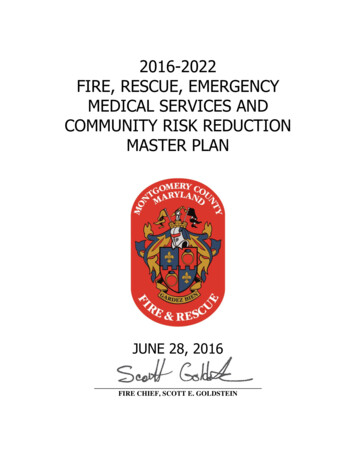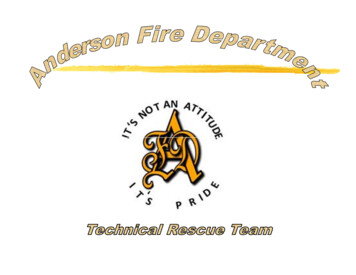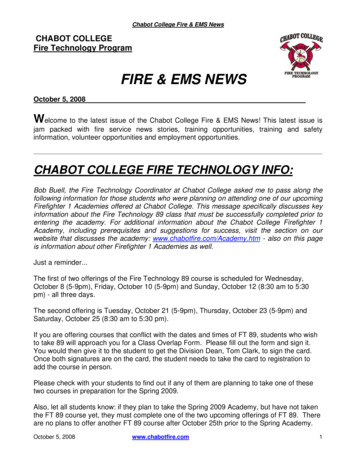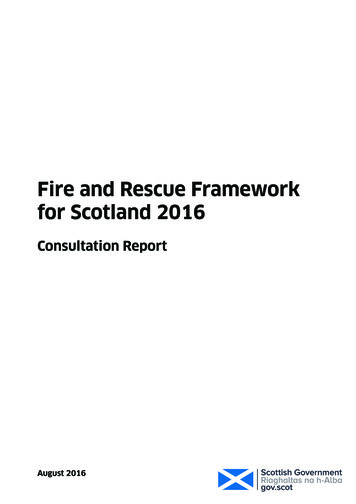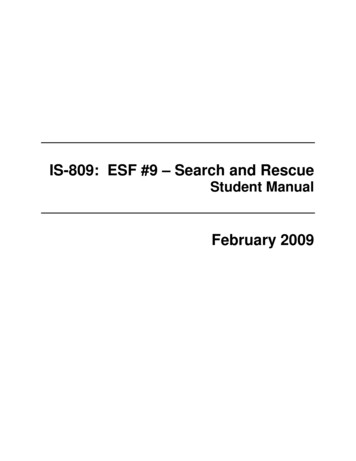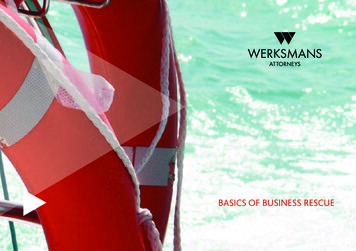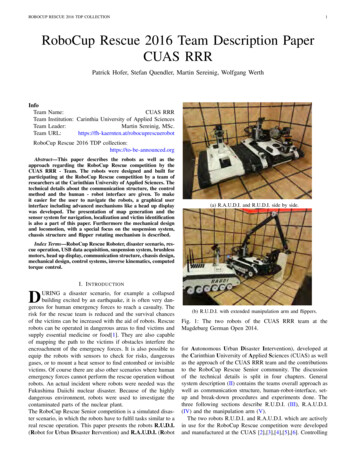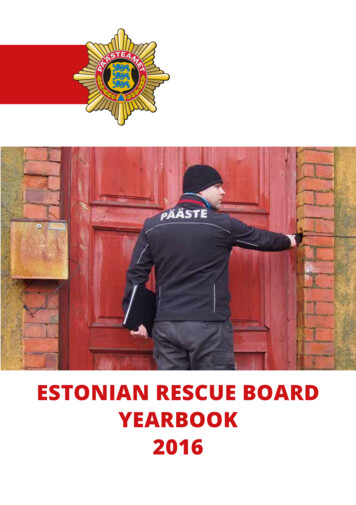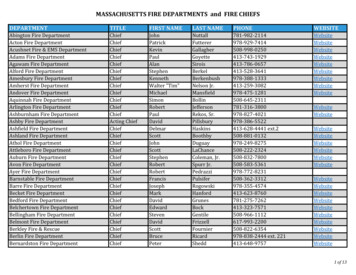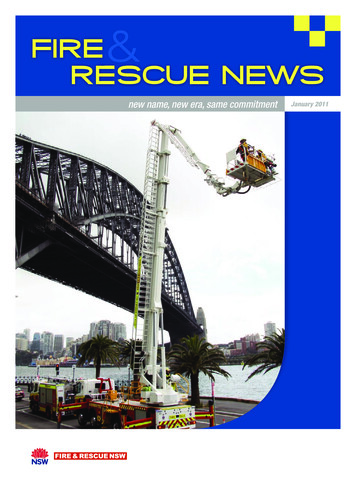
Transcription
FIRERESCUE NEWSnew name, new era, same commitmentD957 Fire and Rescue NSW 40pp A4 Newsletter F.indd 1January 201118/01/11 11:05 AM
CONTENTSINTRODUCTION 3Message from the Minister 3The Commissioner writes 3FIRE AND RESCUE NSW 4New name, new era, same commitment 4Education and training overhauled 6Achieving a more diverse workforce 7HEALTH & SAFETY 8From fat to fit – staff Waste the Waist! 8Keeping your cool with the Rehab Pod 9PREVENTION AND RECOVERY 10Community safety campaigns move into top gear 10Fire Prevention Week 2010: ‘A lot can happen in 3 minutes’ 11Home Fire Safety Audit 11FRNSW Recovery Kit 12The New Zealand experience 12WHAT’S NEW 13IT: Delivering tools for firefighters 1344m ladder platform takes to the road 13Structural firefighting protective clothing consultation 13OPERATIONS 14Firefighters ‘go the whole hog’ in combating silo fire at Young piggery 14 Fire & Rescue News is the officialpublication of Fire and Rescue NSW, andis produced by the Public Affairs andCorporate Communication Strategy Unit.Articles do not necessarily reflect the viewsor policies of Fire and Rescue NSW. Allmaterial is copyrighted and should not bereproduced without the permission of theEditor.Editor: Jan RashbrookT: (02) 9265 3930 F: (02) 9265 28822010 Reference Group: Greg Adams,Phil Clark, Mal Connellan, Kate Dennis,Dawn Easton, Steve Pearce,Jan Rashbrook, John Shenstone,Jim Smith, Lota Vargas, Peter Walker andMark Whybro.Email contributions and feedback to theEditor: FireRescueNews@fire.nsw.gov.auFront cover: Launch of the 44m ladderplatform at the south pylon of the SydneyHarbour BridgePhoto: Jan Crombie-Brown2D957 Fire and Rescue NSW 40pp A4 Newsletter F.indd 2St Marys 6th Alarm fire creates multiple challenges for fire crews 16PROJECTS AND ISSUES 18Fire fatalities: Recognising suicide by fire 18Major hazard facilities and the role of Fire and Rescue NSW 20Fire boats protecting Vancouver and Seattle Ports 22New tool to guide resource allocation 23Risk management in the emergency environment 26PROFILES 32Library: A mine of information 32Captain Ewen Jones: Serving the Narromine community 33Chief Superintendent Gary McKinnon: Following a varied career path 34Corporate Services and Governance 35511 Yass: Celebrates centenary 3643 Seven Hills: Serving the Hills District 37RETIREMENTS & DEATHS 38FIRE & RESCUE NEWS18/01/11 10:37 AM
INTRODUCTIONMessage from the MinisterThe role of the NSW Fire Brigades, and as of 1 January 2011, Fire and RescueNSW, has evolved considerably over the years. The job of a 21st century firefighteris varied and diverse. Today’s firefighters offer expertise in areas ranging from fireinvestigation, firefighting, rescue, and dealing with hazardous materials incidentsto providing advice on prevention and community preparedness. The skills of yourworkforce are recognised not just in NSW but nationally and internationally.Firefighters are regarded as one of the most trusted and respected professionsin the community. However to meet and maintain these high expectations, weshould always look for areas where improvements can be made. To this end,the Director General of the Department of Premier and Cabinet has worked withthe Commissioner in overseeing the development and implementation of reforminitiatives. This partnership approach has helped to build an even healthier, saferand more effective organisation.As the Minister responsible for emergency services I am keen to ensure that Fireand Rescue NSW builds on the hard-earned reputation developed over the lastcentury by the NSWFB, and starts a new century of service on a firm footing ofpositive reforms.Steve Whan MPMinister for Emergency ServicesThe Commissioner writesWelcome to our new flagship publication, Fire & Rescue News, and welcometo our new name – Fire and Rescue NSW. On 1 January this year we saidgoodbye to the name that had served us well for a century – the NSW FireBrigades, and its predecessor from 1884, the Metropolitan Fire Brigade. It wastime to adopt a name that reflects the diversity of our many roles in the communitytoday, spanning prevention and response, and to adopt a more contemporaryname that differentiates us from other agencies. It was also a very symbolic movethat will help to focus us all on our new vision – a vision that is all about being thebest. The best Fire and Rescue service, the best and safest emergency service inwhich to work and contribute, and as a result, the safest communities in Australia.In contrast to previous official journals, Fire & Rescue News will focus more oninformation sharing and technical articles, and all members of the service arewelcome to contribute.Our first edition highlights why we have changed our name and look, the reformswe are undertaking, and how we are constantly reviewing and developing betterways to protect, serve and educate the community, with great success.Maintaining an external service delivery focus is essential to our core business,but there are also times when we must look inwards to ensure that we are justas diligent about reviewing and improving how things are done inside the service,and last year delivered a timely reminder of that need.In 2011, Fire & Rescue News will bring you updates on where we are up to withimproving our structures, systems and processes to increase our efficiency andeffectiveness, insights into developing our leadership skills, and I’ll share mythoughts with you on how we are progressing.As we start to write a new chapter in our proud history, it is important thatwe continue to display the same characteristics of commitment, courageJanuary 2011D957 Fire and Rescue NSW 40pp A4 Newsletter F.indd 3and leadership that we have beenrenowned for – both at and away fromemergency scenes.This journey is not optional, it isa must, and I’d like to take thisopportunity to again thank all of youfor contributing to our journey to makeFire and Rescue NSW the best.Greg Mullins AFSMCommissioner318/01/11 10:37 AM
FIRE AND RESCUE NSWNew name, new era, same commitmentLate last year our organisation tooka significant step and updated thename of the NSW Fire Brigades tomore accurately describe the servicesdelivered to the community of NSW inthe 21st century. On 1 January 2011,our name was officially changed toFire and Rescue NSW.This strategic change heralds a newera for our service, whose long historydates back to 1884, and signals a newway of thinking about who we are andwhere we are going as we move intoour second century of service.We will be focussing more ondeveloping an organisation that isclearly committed to its people, whereleadership is nurtured and developed,and where all staff have a mutualrespect for each other.2010 was a challenging year forthe service, as we faced a series ofcriticisms and serious allegations.Responsibly dealing with the issuesand dealing with all allegations swiftlywas a key priority, and a strongcommitment was made at all levelsto begin the work of building a betterservice.whether it’s at a fire station in Walgett or Darlinghurst, a zone office in Newcastleor the workshop at Greenacre.To ensure the changes are real and lasting, every Fire and Rescue NSW employeewill be required to always recognise and uphold our core organisational values: commitment to safetyhonesty and integrityrespectcourage and selflessnessprofessionalism, andteamwork.Commissioner Greg Mullins has repeatedly said that the vast majority ofemployees, right through from recruits to the senior management team,demonstrate these values on a daily basis.“I believe that people who work for Fireand Rescue NSW do so because theyare committed to making a contributionto the community, and for the most partconsistently demonstrate these valuesin their work.“On 1 January 2011,our name was officiallychanged to Fire andRescue NSW”The Building a Better Brigade program,which started last year aimed todevelop our workforce through moreopen and honest communication at alllevels of the organisation.The Respectful Workplace training,which was also rolled out statewidelast year, was aimed at givingemployees the skills and confidenceto raise difficult issues with colleaguesor managers, and then resolve themin a productive manner, at a local levelwherever possible. Feedback fromstaff who have attended the traininghas been extremely positive.In 2011 we will continue to build onlast year’s good work, developing saferand healthier workplaces, where allstaff feel respected, supported andpositive about their work environments,Photo: Jan Crombie-Brown4D957 Fire and Rescue NSW 40pp A4 Newsletter F.indd 4FIRE & RESCUE NEWS18/01/11 10:37 AM
“Establishing and maintaining a positive workplaceculture is up to each and every one of us”“The generosity of our employeesin donating to the Burns Unit atthe Westmead Children’s Hospital,providing support to colleagues or thethoughtful donation of gifts and foodto the Salvation Army last Christmas,all demonstrate to me the selflessnessand integrity of our staff,” saidCommissioner Mullins.“We have a strong history ofhelping the victims of fires and otheremergencies with compassion andintegrity. As we look to the future,we need to build on these traditionalvalues to ensure we remain one of thecommunity’s most trusted professions.Establishing and maintaining a positiveworkplace culture is up to each andevery one us. By developing andusing new skills combined with thesame dedication and commitmentthat we have always demonstrated,we can build a service that will beacknowledged as the best.”For more information about the futuredirection of Fire and Rescue NSW, visitthe intranet.“Our aim is to buildand maintain safer andhealthier workplaces andto constantly improveour service delivery”Photo: Jan Crombie-BrownJanuary 2011D957 Fire and Rescue NSW 40pp A4 Newsletter F.indd 5518/01/11 10:38 AM
Education and training overhauled“It’s been 20 years since this area ofthe organisation has undergone afundamental review, so this is a greatopportunity to capitalise on bestpractice and tap into resources thatare currently underused.“It’s also about finding out exactly whattraining we need to do and the bestways to deliver it.” Ms Gail Wykes, Director Education and TrainingThe new Education and Trainingdirectorate has embarked on thebiggest overhaul of training deliverywe have seen in 20 years.Gail Wykes, a former NSW EducationDepartment senior executive whohas worked extensively in all areas ofeducation, heads the new directorate.In her most recent role as an educationdirector, Ms Wykes oversaw 28schools in the western Sydney areaand led the professional developmentof 7000 staff in the Western Sydneyregion.“I was looking for something else anda new challenge,” she said.A review in 2010 byconsultants NoeticSolutions found the formerLearning and Developmentstructure did not optimiseNSWFB resources, andrecommended the creationof a new Education andTraining directorate.Ms Wykes said the directorate’s aimis to ensure all staff across Fire andRescue NSW have access to ongoingdevelopment and training to maintainand build skills.“We want to ensure the righteducational and training systemsand processes to operatesuccessfully in the 21st century”“Once the people are in place we willgo through a consultation process withthe rest of the staff, perhaps througha survey, to find out what skills andtraining they want and need to takethem into the future,” Ms Wykes said.“We want to ensure the righteducational and training systemsand processes are in place to deliverwhat our people and the organisationrequire to operate successfully in the21st century,” she said.“Our vision will be based on thetraining and education issues andneeds firefighters and other staff raiseduring that consultation, as well asour strategic planning around Fire andRescue NSW’s roles and capabilities.”“The challenges ahead will includepeople wanting to do things differentlyto how they have done them in thepast and, perhaps in some instances,they will need new skills to do that,”she said.The new directorate will also look atreviewing and realigning training andskills levels with ranks.Fire and Rescue NSW will also beseeking to improve leadership andmanagement skills in order to createa more effective organisation thatably meets the many challenges anddemands that face modern emergencyservices.“It’s really interesting coming from anorganisation where you have workedfor 30 years to this one which is sodifferent.”“But as I tell my former colleagues, I’mstill in education. It’s just it’s not withschools anymore, it’s with Fire andRescue NSW.”“There are vital skills that are taughtin firefighters’ basic training, but atthe moment the means of obtainingadditional skills varies,” Ms Wykessaid. Computer-based training is part of the new curriculum“Adult education is wonderful. A lotof my time has been spent looking atthat area and this new role is a greatopportunity.”Ms Wykes said the aim of thedirectorate is to ensure that firefighters,administration and trades staff receivethe ongoing training and developmentthey need to be part of a diverse,skilled and adaptable workforce.“People out there recognise thatongoing education and training is vitalfor Fire and Rescue NSW to moveforward,” she said.Photos: Jan Crombie-Brown6D957 Fire and Rescue NSW 40pp A4 Newsletter F.indd 6FIRE & RESCUE NEWS18/01/11 10:38 AM
Achieving a more diverse workforcePhoto: Jan Crombie-Brown“As part of our workplace reformprogram, I encourage all our staff tolearn about and understand the needfor greater diversity in our workforce,”said Commissioner Mullins.“We need to better reflect thecommunities that we serve so that wecan better understand their issues andrisks. Our organisation will be so muchricher if we become more diverse, andour work for the community will besignificantly enhanced.”Fire and Rescue NSW’s EEOManagement Plan 2010 – 2012is central to achieving greatestdiversity. The Plan will help to facilitatethe recruitment, participation andpromotion of Equal EmploymentOpportunity (EEO) groups within theworkforce, reflecting the NSW publicsector’s commitment to developinga workplace culture that supportsemployment equity and diversityprinciples.The EEO Management Plan is ahigh-level blueprint with a focus onstrategies and performance indicatorsto enhance the employment andparticipation of women, Indigenouspeople and those from diverse culturaland linguistic backgrounds within theworkforce. It aligns with the CorporatePlan in working towards goals toattract, retain and develop a diverse,skilled and adaptable workforce, andcontinuing to improve service deliveryand develop capabilities to meetcommunity needs. L-R: Jason Hardy, Joseph Javillonar and Nicole Davis“To make this plan work for Fire and Rescue NSW, it needs the active involvementin, and commitment to, the principles of EEO and workplace diversity from allemployees,” concluded Commissioner Mullins.Many of the strategies aimed at developing a more diverse workforce are alreadyunder way. A Diversity Summit was held at Parliament House in Sydney with 100permanent and retained firefighters, administration, trades and technical staff.They discussed how to increase the diversity of the workforce, and particularlyhow to increase the number of women interested in a firefighting career.Retained Firefighter Sissi Sawyer from Yass Fire Station said the summit was notonly very informative but provided many insights as to how Fire and Rescue NSWcould further diversify its workforce.“The Summit was a terrific experience for me as a Retained Firefighter. Not onlydid I learn more about the operational side of Fire and Rescue NSW but also onhow, through personal experience, we can encourage other women to consider acareer as a firefighter.”In July 2010, a Women in Firefighting Conference was held undertheme “Resurgence – Becoming Stronger”. Fire and Rescue“Fire and Rescue NSW needs to better theNSW co-hosted the conference, with the Victorian Country Firereflect the communities that we serve” Authority and Women and Firefighting Australasia Inc. SecretarySF Cathryn Dorahy assisted in organising the event. Onehundred and fifteen representatives from fire services around Australia attended.Commissioner Mullins commendedSF Dorahy described how much the conference benefited those attending.the plan. “Achieving greater diversity“Personally I gained a lot from the conference delegates and the presenters,in our workforce has nothing to dolearning from their experiences this has given me further confidence andwith being trendy or politically correct,belief in my ability to progress and achieve the goals I have set for my career.it’s about doing the right thing. AboutThis sentiment was echoed by many delegates all delegates welcomed theensuring that men and women fromopportunity to network with other like-minded women in firefighting.”all backgrounds and beliefs have justFire and Rescue NSW has developed employment strategies to attractas much opportunity to be a firefightermore female applicants. We also appointed an Aboriginal Employment andas I did when I joined. The fact is thatDevelopment project officer, Lisa Williams, to help develop a comprehensivethey haven’t in the past, and we needIndigenous employment strategy.to work out why this is, remove anyunnecessary barriers, and welcomeThe EEO Management Plan can be found in the Human Resources section of thepeople into the service.”intranet.January 2011D957 Fire and Rescue NSW 40pp A4 Newsletter F.indd 7718/01/11 10:38 AM
HEALTH & SAFETYFrom fat to fit – staff Waste the Waist!Did you knowMore than 3.4 million Australiansare affected by cardiovasculardisease, which claims one lifeevery 10 minutes? The biggestrisk factor for this disease isabdominal obesity. More than54% of Australian adults areeither overweight or obese.At the beginning of 2010, the Healthand Fitness team introduced theWaste the Waist program, which aimsto improve the cardiovascular profileof FRNSW employees and reduce therisk of both on and off-duty cardiacevents, injury and illness.The 12-week program encouragesparticipants to monitor what and howmuch they eat on a daily basis and toincrease the amount of exercise theyundertake, with help from the website,which calculates kilojoules consumedcompared to kilojoules expended.As well as a 4 cm loss from my waist,my clothes fit better and I generally feelmuch healthier. I have worked hardto keep up the fitness and I am nowas fit as I was when I first joined theorganisation.”The second round of the Wastethe Waist program began on 13September. For more informationabout Waste the Waist, visit the Healthand Safety intranet site, or contactthe Health and Fitness Officer for yourarea.More than 700 employees signed up for the first round of the 12-week Wastethe Waist program. To make it interesting, participants could elect to competefor prizes as individuals, platoons, stations or sections. The winners were chosenbased on overall lifestyle improvement, and incorporating sustainable, healthypractices into their daily routine.Overall, participants collectively lost 1302 kilograms, the equivalent of more than90 breathing apparatus sets and cylinders in weight, and lost 1435 centimetresoff their waists, nearly half a length of hose. On average, those who took part lost2.7% (or 2.6 kg) of their initial body weight, 2.9 cm from their waist and had anoverall reduction in body mass index of 0.8.F Platoon firefighters from 216 Bathurst were named the State PermanentFirefighter group winners, losing in excess of 30 kg. Retained Firefighter MandyLaw from the Raymond Terrace Brigade was awarded the top individual prize.In a fantastic effort, Station Officer Peter Willard from 216 Bathurst lost morethan 16kg and shed 11 cm from his waistline. He said the program was great forstation morale.“The program not only encouraged us to reach our individual goals but we reallybecame supportive of helping others in the station to achieve their goals. Weightloss is hard at the best of times, but making a commitment and sharing it withyour peers really helps you to stay focused and on-track.”One of the most vital components of the program is the Waste the Waist website.It educates participants on how to achieve a negative energy balance (ie whenenergy used exceeds energy consumed) which is the premise for weight loss.Participants in the program enter their daily food intake and exercise activitiesand the website then calculates the kilojoules consumed, and compares this tothe kilojoules expended through physical activity. It also provides meal plans, afirefighter’s cookbook and information on how to read and understand food labels.Analysis from the first competition showed that participants who entered foodand exercise information into the website more than five times per week lost, onaverage, 6.9 cm from their waist compared to less than 1 cm for participants whoentered information less than twice per week, for the duration of the program.Superintendent Tom Cooper was one of the first people to try out the Waste theWaist pilot program and said he’s proof that it helps deliver real health benefits.“The web program is really simple to use, particularly for working out how tomanage your calorie intake, something I’d never given much thought to before.Photo: Jan Crombie-Brown8D957 Fire and Rescue NSW 40pp A4 Newsletter F.indd 8FIRE & RESCUE NEWS18/01/11 10:38 AM
Keeping your cool with the Rehab PodFire and Rescue NSW is the first fireagency in Australia to introduce aninnovative Rehab Pod.The Rehab Pod assists firefightersto reduce and avoid the effects ofheat stress. There are two unitsavailable, at Greenacre, with fleetdrivers maintained on an on-call basisto deploy the Pods in the SydneyBasin. Each unit contains an array ofequipment including shades and chairsas well as medical and refreshmentsupplies.Kore Kooler helps firefighter cool down “When I was on exchange with theOttawa Fire Services in 2007, I sawthe chairs being deployed and thoughtthey were an excellent idea. Theycan be used in any situation wherethere is a need to quickly reduce corebody temperatures. The chairs areused in many Canadian and US FireDepartments. They are also usedextensively in construction trades,commercial bakeries, the Canadianmilitary and by sports teams lookingto maintain performance and protectpeople from the effects of heat stress,”Kevin said.“The Rehab Pod is designedto assist firefighters reduce theeffects of heat stress”Central to the effective operation of thePod is the Kore Kooler rehabilitationchair, which features arms speciallydesigned to hold ambient temperaturewater to quickly cool down firefighterson the fireground. There are 15 chairsper Pod.Station Officer Kevin Smith wasinstrumental in introducing the KoreKooler chair into the organisationfollowing his experience during aninternational firefighter exchange toCanada, where he learnt firsthandabout the chairs, even managing tobring a couple of samples back withhim.“Defence Research andDevelopment Canada, togetherwith the Workplace Safetyand Insurance Board Ontario,have undertaken studiesdemonstrating that forearm immersionis the most effective way to reducecore body temperatures. The KoreKooler chair offers active cooling,working a bit like the heat exchangeunit on a radiator or air conditioner.”Speaking at a recent informationsession, Chief Superintendent GerryByrne, Assistant Director OperationalLogistics said the development of theRehab Pod was a collaborative effort.“We established the RehabilitationWorking Group in 2007 to ensurerepresentation across theorganisation,” he said.Photo: Jan Crombie-Brown“The Rehab Pod has been developedas a result of extensive consultationand inter-directorate cooperation.It continues to be refined anddeveloped.”The Fleet Workshop and Storespersonnel were involved in fitting outthe interior of the pod. Fleet Transportdrivers deliver and collect the RehabPod to and from the incident ground.After an incident, the pod is checkedand restocked by Logistics Supportpersonnel from Greenacre.The Rehab Pod was commissionedearlier this year and was deployedeffectively at the Liverpool CouncilChambers fire on 15 August.Superintendent Paul Bailey whoattended the incident said that the newappliance was instrumental in allowingfirefighters at the scene to recoverquickly.“The Rehab Pod was crucial to ourincident response at the LiverpoolCouncil fire, providing firefighters witha safe place of refuge, away from thefire with the appropriate sustenance,water and a place to cool down andrecover.”Transportable Rehab PodPhoto: Jan Crombie-BrownJanuary 2011D957 Fire and Rescue NSW 40pp A4 Newsletter F.indd 9918/01/11 10:38 AM
PREVENTION & RECOVERYCommunity safety campaigns move into top gear2010 was an exciting year forcommunity initiatives as we started totake a more sophisticated approachto how we developed and deliveredcampaigns and resources to helpfirefighters make their communitiessafer.We embarked on anumber of successfulcommunity fireprevention andeducation campaignsthis year.of elderly fire fatalities last winter.CALD participants were less likely to have fire safety equipment in their home andwere more likely to cook with oils and fats.Time, effort and cost were all identified as barriers to people adopting fire safetybehaviour but of biggest concern was a prevailing attitude that it ‘won’t happen tome’. Almost all the participants agreed that a fire safety awareness program wasneeded to jar them out of complacency.“Research found that manypeople had become complacentabout fire safety practices”Among them were the usual suite offire safety initiatives: Fire PreventionWeek, Brigade Kids Day, Fire StationOpen Day, Seniors Fire Safety and theWinter Fire Safety campaign.On the back of robust research andanalysis and with the support of ourmajor community partners, we wereable to develop two new importantresources – Recovery Kits and theonline Home Fire Safety Audit tool.In 2010, through the CommunityEngagement and Development Unit(CEDU), we commissioned a researchcompany, TNS, to look into communityawareness and attitudes about firesafety in the home. TNS used focusgroups, in-depth interviews and asurvey of 385 NSW residents.The research found that many peoplehad become complacent about firesafety practices such as checkingsmoke alarm batteries and havinghome escape plans. Most didn’tconsider themselves and their ownhousehold at a high risk of fire. Theresearch also identified alarmingpractices and attitudes toward firesafety in high-risk groups such asseniors and culturally and linguisticallydiverse (CALD) communities.The 2010 Winter Home Fire Safety campaign,devised by the SMART advertising agency, wasapproved after undergoing a stringent peerreview process. The aim of the campaign wasto raise public awareness and understandingof fire prevention in the home, especiallyamong seniors, families with young children, CALD communities and lowersocioeconomic groups. Its focus was on how a home fire can take hold in justminutes, but taking simple fire prevention steps takes only seconds.Simple measures such as turning off the stove when you leave the kitchen,moving heaters away from flammable materials and checking power pointsweren’t overloaded were highlighted, as well as advice on smoke alarms and apractised home evacuation plan, were promoted.The campaign was launched on 31 May, with the key message ‘A lot can happenin 3 minutes’.CEDU Sponsorship Coordinator Chris Fish said FRNSW’s major communitypartners, McDonald’s and insurer GIO, helped provide firefighters with theresources to support the Winter Fire Safety campaign and other initiatives.“It gives our firefighters the tools to go out and engage with the community in aprofessional way,’’ he said.Follow-up research to measure the success of the Winter Fire Safety campaignis under way. The findings from this will be compared to the earlier benchmarkresults from the TNS study.“The research will look at how we ran the campaign and whether it got ourmessages through,” Mr Fish said. “We can then use that information to refine whatwe need to do to strengthen campaigns.”CALD Coordinator David Weir spreads the safety message at Harmony Day Seniors expressed a greater intentto try to ‘put the fire out’ during anincident and believed they had plentyof time to evacuate the house. Theywere also less likely to regularly checktheir smoke alarms. These researchresults were reflected in a high numberPhoto: Jan Crombie-Brown10D957 Fire and Rescue NSW 40pp A4 Newsletter F.indd 10FIRE & RESCUE NEWS18/01/11 10:39 AM
Fire Prevention W
FIRE RESCUE NEWS new name, new era, same commitment January 2011 D957_Fire and Rescue NSW 40pp A4 Newsletter F.indd 1 18/01/11 11:05 AM
